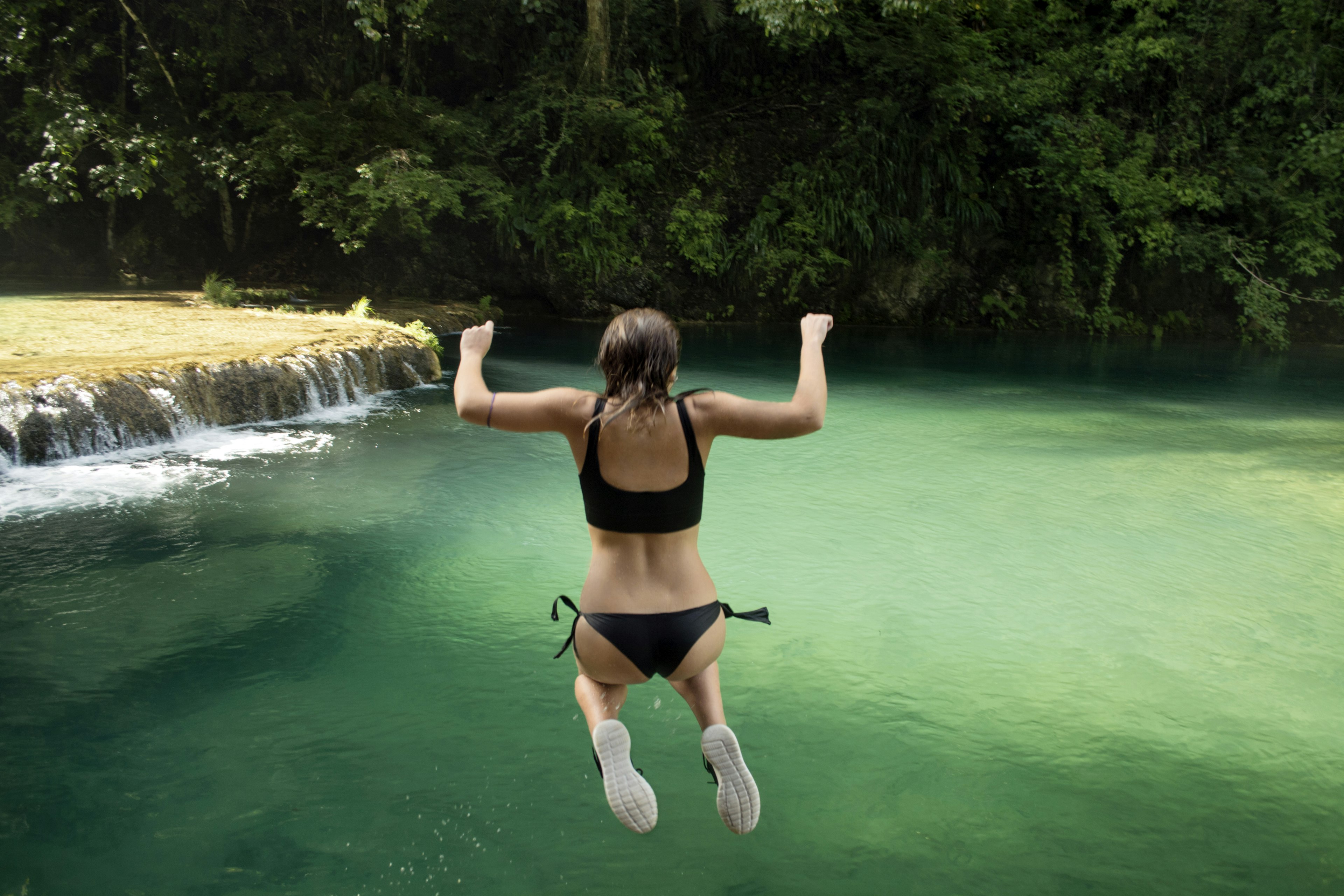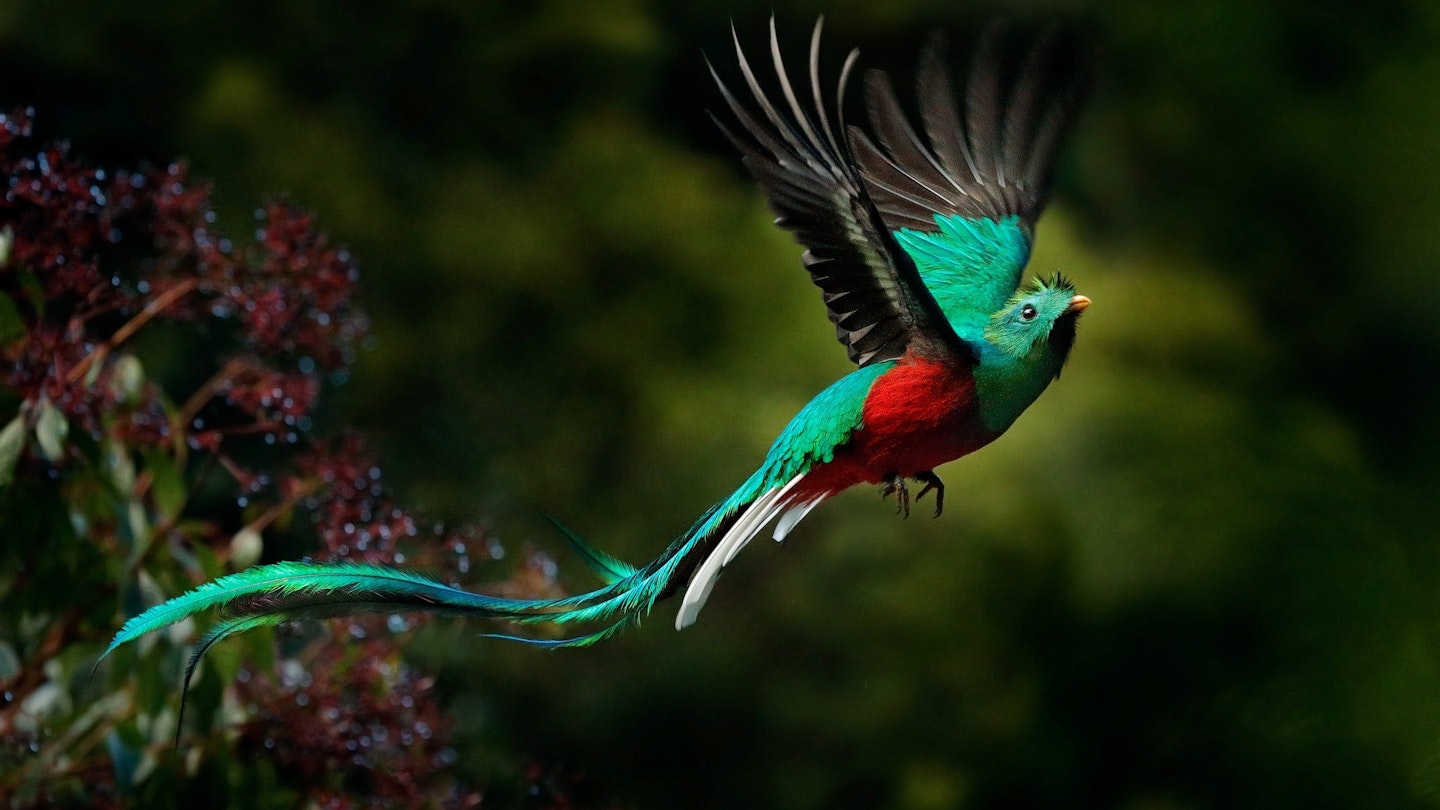Guatemala is brimming with diverse wildlife, tropical rainforests, and some of the oldest and most awe-inspiring ruins in the world.
Whether you want to trek through the jungle trying to spot an elusive jaguar or climb an active volcano to roast marshmallows over cooled lava, Guatemala has no shortage of outdoor activities for nature lovers.
The largest protected area in the country is the Maya Biosphere Reserve, located in the northern region of El Petén. This region houses national parks and reserves with vast swaths of rainforest. Some parks are easily accessible, like the iconic Tikal, while others, for the truly intrepid, include the remote ruins of El Mirador, accessible only via a five-day trek through the jungle. Regardless of your adventure level, this part of the country is where most of Guatemala’s biodiversity resides, and you shouldn’t miss it.
History Lovers Should Head to Parque Nacional El Mirador
In 1926, as pilot Charles Lindbergh flew over the jungle in northern Guatemala, he saw what he believed were volcanoes rising from the trees. Upon closer inspection, the ruins of El Mirador turned history on its head when experts discovered that this ancient city predates Tikal. Partial excavations revealed that El Mirador thrived at least 2000 years ago and was arguably the first state-level society in the Western Hemisphere. The park also features La Danta, one of the world’s largest pyramids by volume, alongside ancient art depicting scenes from the Popol Vuh, a foundational sacred text of the Maya.
The jungle surrounding the ruins is incredibly diverse, showcasing five types of tropical forests filled with towering ramon and sapodilla trees. Jaguars and pumas are known to roam this area, serving as a crucial migration point for birds, making it a bird-watcher’s paradise. The limestone cliffs represent the last known habitat for the orange-breasted falcon, while rare harpy eagles also inhabit this region.
However, there’s a catch: the El Mirador ruins can only be reached by a five-day trek through the jungle or via private helicopter. Jungle hikes can be arranged in the small town of Carmelita, situated just outside Flores in El Petén.

Hike a Rumbling Volcano at Parque Nacional Volcán de Pacaya
Standing tall at 2552m (8372ft), Volcán Pacaya is Guatemala’s most popular hike, and it’s easy to see why. As one of Central America’s most thrilling volcano treks, this active mountain is safe to climb; visitors can even roast marshmallows over cooled lava upon reaching the summit. Volcán Pacaya is the perfect day trip destination from either Guatemala City or Antigua. The well-maintained trails, equipped with good signage, public bathrooms, rest stops, and numerous snack vendors, make this hike accessible for almost everyone.
The trail leads you through forests and farmland before opening onto cooled lava fields near the summit. Horse rentals are available to assist with the trek, allowing for an easy ascent or the option to ride if tired. Regardless of how one chooses to conquer the climb, the breathtaking views from the summit of surrounding volcanoes, including Agua, Fuego, and Acatenango, are more than worth the effort.
Spot Guatemala’s National Bird at Biotopo del Quetzal
The striking red-and-teal quetzal is Guatemala’s national bird, revered since long before the conquistadors arrived. Quetzals have been immortalized in murals and tattoos throughout the country; even Guatemala’s currency carries the name of this iconic bird. To witness one in its natural habitat, a visit to the Biotopo del Quetzal south of Cobán is essential.
Seeing a quetzal is largely a matter of luck, but statistically, the chances are higher here than elsewhere in the country. This 2580-acre park focuses on the conservation of cloud forest and the wildlife inhabiting it, including the quetzal, which is now, unfortunately, endangered.
The park features two moderately challenging trails, one 2km (1.2 miles) and another 4km (2.5 miles), each leading up a small mountain filled with massive ferns, bromeliads, and orchids. The diverse flora includes pine, cypress, and eucalyptus trees that shelter tropical birds such as the emerald toucanet and forest falcons alongside the quetzals. At the trails’ end, you can cool off in waterfalls before returning. The best seasons to see quetzals are March and June, just before or after their nesting period.
Take a Relaxing Boat Tour at Parque Nacional Río Dulce
The Río Dulce National Park, a 30km (18.6-mile) river surrounded by 18,000 acres of wetlands, offers the most enjoyable way to explore the reserve by boat. Tours departing from the town of Río Dulce provide a leisurely two-hour ride, perfect for spotting wildlife along the way. The mangroves are home to crocodiles and harbor one of the last known habitats for the endangered manatee. A jungle canyon sits at the river’s mouth, making it a favored location for bird-watchers aiming to see hawks, herons, egrets, and kingfishers.
As you navigate farther along the river, a remarkable rock face adorned with jungle greenery and bromeliads referred to as La Cueva de la Vaca provides a picturesque stop for photographs. Overnighting in this pristine wilderness is possible with many jungle lodges along the Río Tatin, a tributary that branches off of Río Dulce, just upstream from the canyon.

Parque Nacional Semuc Champey: Ideal for Water Enthusiasts
Deep within the lush jungle of the Alta Verapaz department lies Semuc Champey, a breathtaking series of tiered turquoise pools situated atop a natural limestone bridge over the Cahabón River. This park is one of Central America’s most stunning locations, and despite its challenging access, the journey is undeniably rewarding.
The park features a 30-minute trek through rich vegetation teeming with butterflies, tropical birds, and busy iguanas, ending at a mirador that boasts stunning views of the tranquil pools nestled within the verdant gorge below. It’s a park where visitors are encouraged to linger throughout the day, swimming, sunbathing, and soaking in the captivating natural beauty. Nearby K’anba Caves offer the chance for unforgettable candle-lit swims through an underground river cave system, often considered a fantastic companion to the park experience.
Enjoy Swimming and Camping at Parque Nacional Laguna Lachuá
This colorful tropical forest in Alta Verapaz is home to the pristine and tranquil Laguna Lachuá, a clear, cool turquoise lagoon complete with a long wooden dock perfect for swimming. Visitors reach the lagoon via a 5km (3-mile) trail through humid subtropical rainforest, rich with foliage and wildlife. Expect to encounter hummingbirds, tapirs, monkeys, and even the occasional tarantula.
Upon arrival, visitors will delight in spotting various marine birds, including storks, ducks, pelicans, egrets, and herons. The park is particularly popular for overnight trips due to the campsite located right beside the lagoon, equipped with a palapa for tents in case of inclement weather. This site offers amenities like washrooms and a “camp kitchen” for meal preparation, with a friendly park ranger on duty 24/7 for assistance. Importantly, to preserve the lagoon’s ecosystem, visitors are prohibited from using bug repellent, soaps, and chemical sunscreens while swimming, and fishing or consuming alcohol within the park is not permitted.

Parque Nacional Tikal: Guatemala’s Best National Park
Without a doubt, Tikal should rank at the top of your list of places to explore in Guatemala. Once the capital of the Maya, this stunning ancient city was rediscovered in 1848, although significant excavations began only in 1951.
The expansive park spans 575 sq m (6189 sq ft) and boasts over 200 structures, with some still partially consumed by dense jungle. Tikal reached the zenith of its power in the 7th century, and the remnants of this kingdom illustrate the extraordinary sophistication of Maya society. The resilient limestone buildings comprise residences, royal palaces, administrative structures, and various temples and pyramids, the most awe-inspiring being Templo IV. At 65m (213ft) tall, it provides an unforgettable vantage point, particularly at sunrise.
A Unesco World Heritage Site, Tikal is distinguished by its cultural significance and exceptional biodiversity. Legend has it that jaguars and pumas still wander the park by night, while countless tropical bird species, including hummingbirds, parrots, and toucans, can be spotted during the day. The experience of weaving through the jungle, listening to howler monkeys, and marveling at colossal ceiba trees is equally captivating as the ruins themselves.
While most historians attribute the city’s abandonment to drought and deforestation, the precise reasons behind the fall of the Tikal kingdom remain a mystery, adding to the intrigue of this remarkable site.




